A blocked carotid artery can feel overwhelming, but understanding its impact on your health can help you make informed decisions. The carotid arteries, located on either side of your neck, are vital blood vessels that deliver oxygen-rich blood to your brain. When plaque buildup narrows or blocks these arteries, it raises serious health risks, including stroke. In this article, we’ll dive into what a blocked carotid artery means, its symptoms, risks, treatment options, and how it affects life expectancy with blocked carotid artery. Whether you’re asking, “How long can you live with a blocked carotid artery?” or curious about living with a 70% or 90% blockage, we’ve got clear, actionable insights to guide you.
What Is a Blocked Carotid Artery?
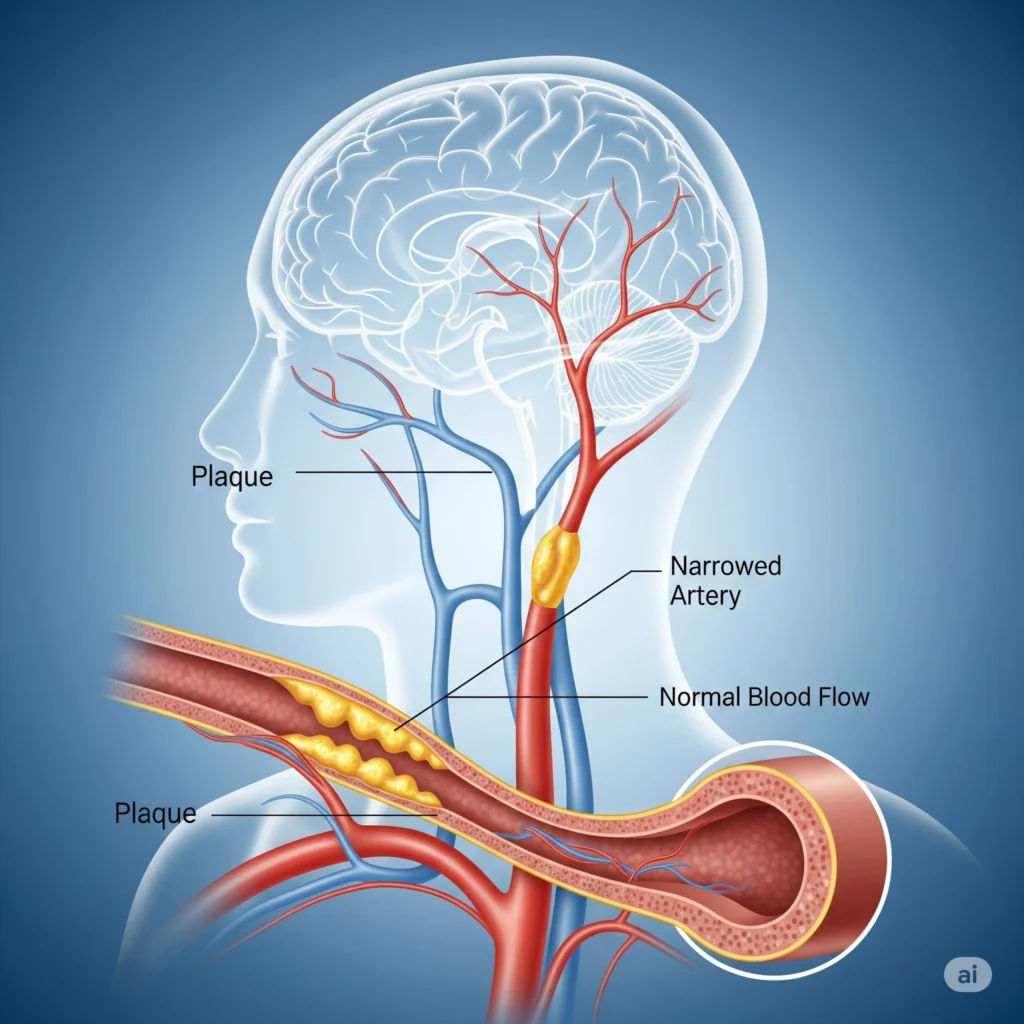
A blocked carotid artery occurs when plaque, made up of fat, cholesterol, and other substances, builds up inside the artery walls. This condition, often called carotid artery disease or atherosclerosis, narrows the arteries and restricts blood flow to the brain. In severe cases, the artery can become completely blocked, significantly increasing the risk of stroke.
Carotid artery disease is often linked to hardening of the arteries, also known as atherosclerosis, which can affect blood vessels throughout the body, including those in the brain (cerebral atherosclerosis). Risk factors include high cholesterol, high blood pressure, smoking, diabetes, and a family history of heart disease. As we age, the likelihood of plaque buildup increases, but the average carotid artery blockage by age varies widely depending on lifestyle and genetics.
Symptoms of a Blocked Carotid Artery
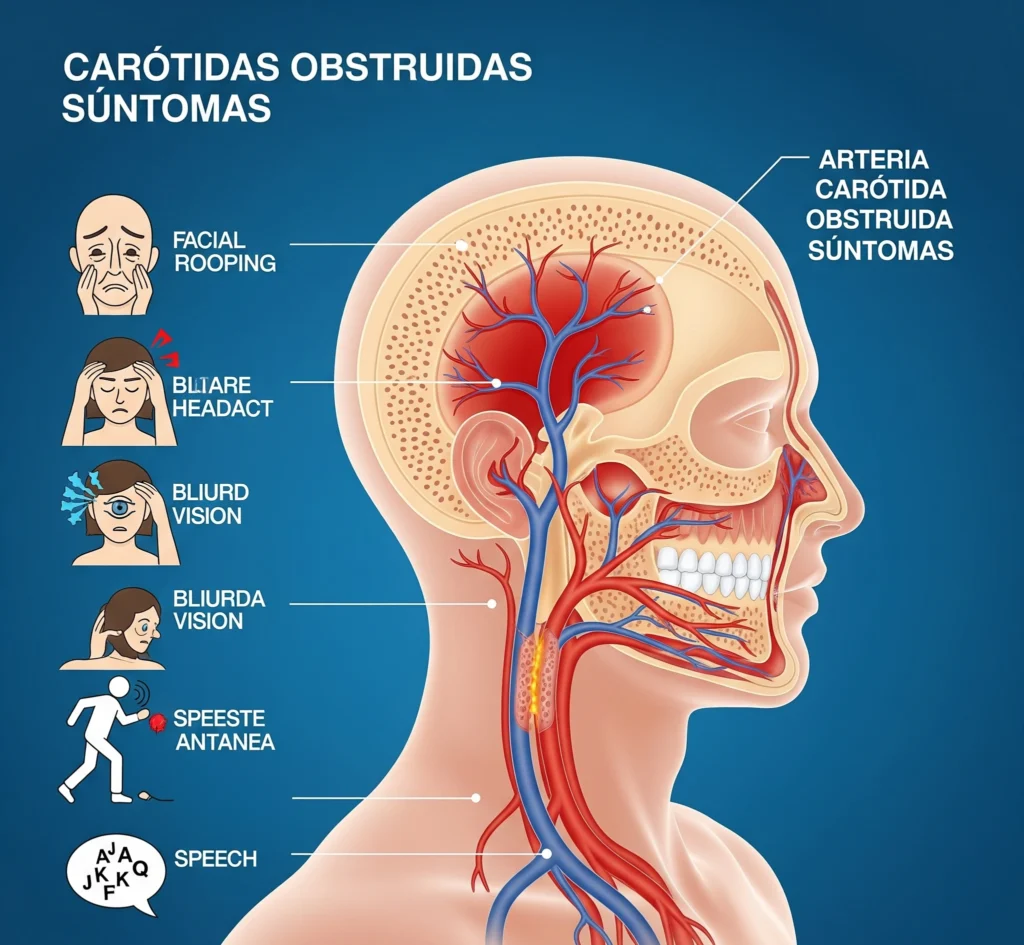
Many people with a blocked carotid artery don’t experience symptoms until the blockage becomes severe or causes a stroke or transient ischemic attack (TIA), often called a “mini-stroke.” Knowing the warning signs of a blocked carotid artery is crucial for early detection:
- Sudden numbness or weakness in the face, arm, or leg, especially on one side of the body
- Difficulty speaking or understanding speech
- Sudden vision problems, such as blurred vision or loss of vision in one eye
- Dizziness or loss of balance
- Severe headache with no known cause
In Spanish, these symptoms are referred to as carótidas obstruidas síntomas or arteria carótida obstruida síntomas. If you experience any of these, seek medical attention immediately, as they could indicate a serious issue like a 90% blocked carotid artery or even a 100% blocked carotid artery.
How Serious Is a Blocked Carotid Artery?
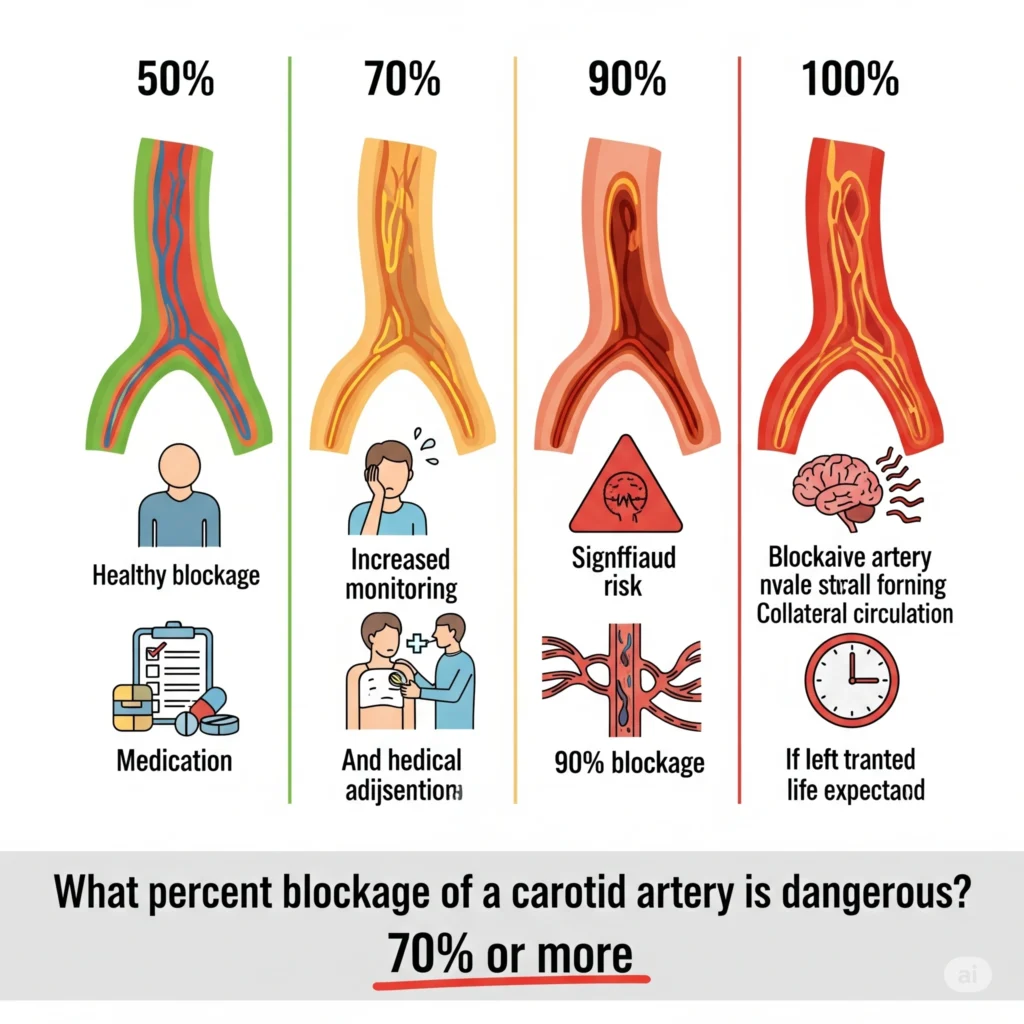
The seriousness of a blocked carotid artery depends on the percentage of blockage and whether symptoms are present. Doctors typically measure blockages as a percentage, such as a 50% blocked carotid artery, 70% blocked carotid artery, or 90% blockage in carotid artery. Here’s a breakdown of what these percentages mean:
| Blockage Level | Severity | Symptoms | Life Expectancy Outlook |
| 50% blocked | Mild | Usually none | Normal with lifestyle changes |
| 70% blocked | Moderate–Severe | Possible TIAs, dizziness | Can live with it; stroke risk increases |
| 90% blocked | Severe | High stroke risk | Requires urgent medical or surgical treatment |
| 100% blocked | Critical | Often stroke present | Possible with collateral flow; prognosis varies |
- 50% Blockage: A life expectancy with 50% blocked carotid artery is generally not significantly impacted if managed properly. Many people live without symptoms at this level, but lifestyle changes and medications are often recommended to prevent progression.
- 70% Blockage: A 70% blocked carotid artery is considered moderate to severe. You may still be able to live a normal life with proper treatment, but the risk of stroke increases. The question “Can you live with a 70% blocked carotid artery?” is common, and the answer is yes, with medical management, but close monitoring is essential.
- 90% Blockage: A 90% blocked carotid artery is highly serious, as it significantly restricts blood flow. How serious is a 90% blocked carotid artery? It carries a high risk of stroke, and immediate treatment, often surgery, is typically recommended.
- 100% Blockage: A 100% blocked carotid artery means the artery is completely closed off. Surprisingly, some people can live with a 100% blocked carotid artery if the body develops alternative blood pathways (collateral circulation). However, the life expectancy with 100% blocked carotid artery may be reduced without intervention, especially if symptoms like stroke occur.
What percent blockage of a carotid artery is considered to be dangerous? Generally, blockages of 70% or higher are considered high-risk, particularly if symptoms are present. For example, life expectancy with blocked carotid artery with symptoms is often lower than without symptoms due to the increased likelihood of stroke.
Life Expectancy with Blocked Carotid Artery
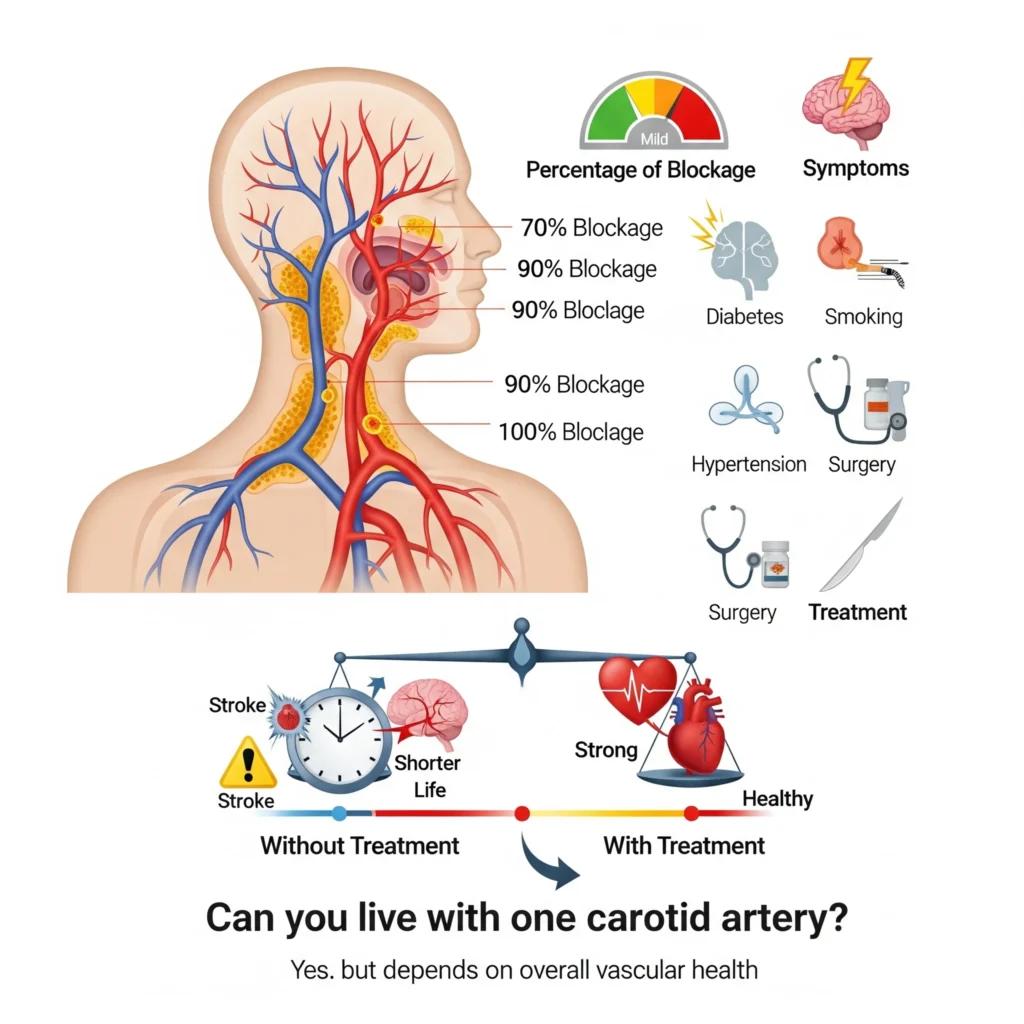
The question “What is the life expectancy of a person with a blocked carotid artery?” doesn’t have a one-size-fits-all answer. Several factors influence how long you can live with a blocked carotid artery:
- Percentage of Blockage: As mentioned, a life expectancy with 70% blocked carotid artery is generally better than with a 90% blockage carotid artery or 100% blocked carotid artery.
- Symptoms: Symptomatic blockages, such as those causing TIAs or strokes, reduce life expectancy more than asymptomatic ones.
- Overall Health: Conditions like diabetes, high blood pressure, or smoking can worsen outcomes.
- Treatment: Timely intervention, whether through lifestyle changes, medications, or surgery, can significantly improve life expectancy with blocked carotid artery.
For example, how long can you live with 90% blockage or how long can you live with 95% blockage depends on whether you pursue treatment. Without intervention, severe blockages can lead to stroke, which may drastically reduce life expectancy. In cases of life expectancy with blocked carotid artery after stroke, outcomes vary based on the stroke’s severity and the patient’s recovery.
Can you live with one carotid artery? In rare cases where one carotid artery is completely blocked, the body may rely on the other carotid artery or collateral blood vessels. While it’s possible to live with one functional carotid artery, the life expectancy with blocked carotid artery in this scenario depends on overall vascular health.
Can You Live with a Blocked Carotid Artery Without Surgery?
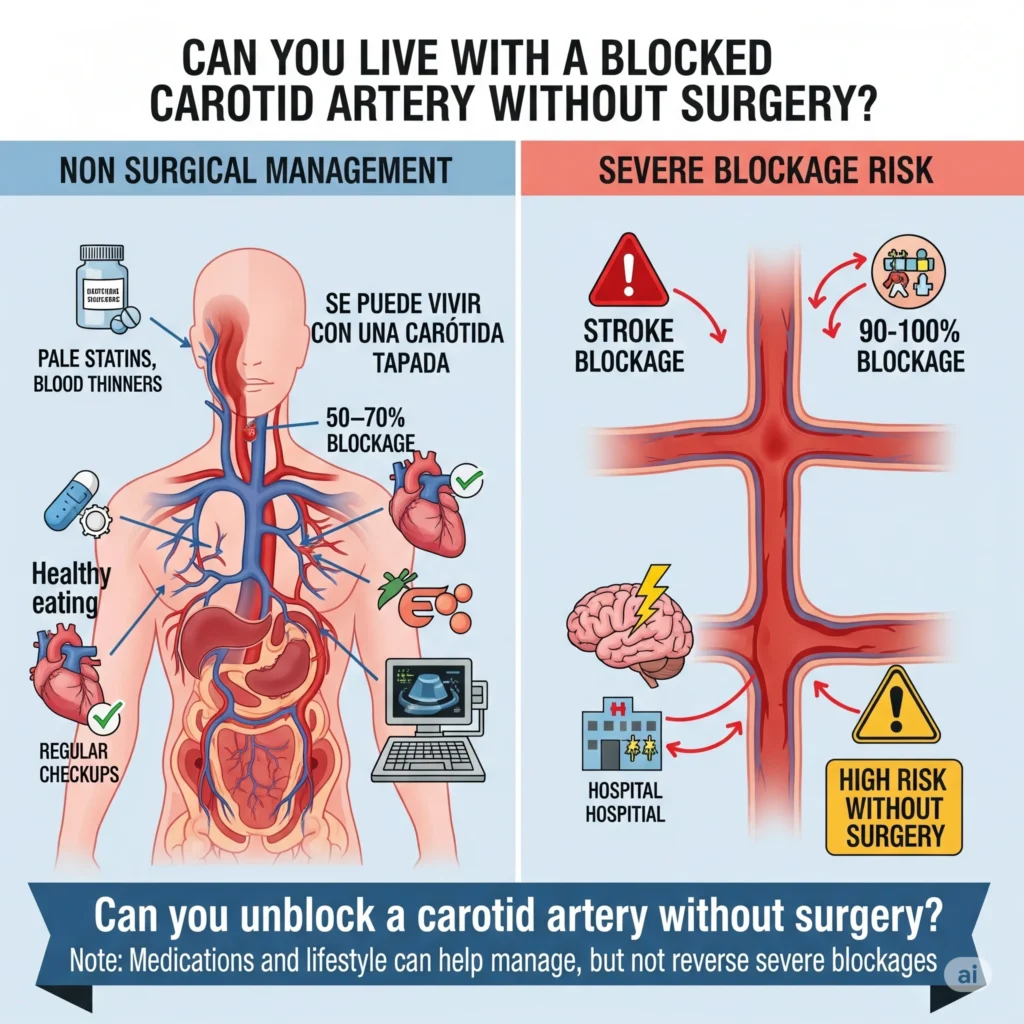
Many people ask, “Can you live with a blocked carotid artery without surgery?” or in Spanish, “Se puede vivir con una carótida tapada?” The answer depends on the blockage’s severity and your overall health. For mild to moderate blockages, such as a 50% blocked carotid artery or even a 70% blocked carotid artery, non-surgical treatments can be effective:
| Treatment Method | Used For | Improves Life Expectancy? | Notes |
| Medication only | Mild–moderate blockage | Yes (if managed strictly) | Blood thinners, statins, BP control |
| Lifestyle changes | All stages | Yes | Diet, no smoking, daily activity |
| Surgery (Endarterectomy) | 70–99% blockage | Significantly | Prevents stroke in high-risk cases |
| No treatment (watch only) | Some mild cases | Risky | Only under strict medical guidance |
- Medications: Blood thinners (e.g., aspirin), cholesterol-lowering drugs (statins), and blood pressure medications can reduce the risk of stroke.
- Lifestyle Changes: Quitting smoking, eating a heart-healthy diet, exercising regularly, and managing diabetes can slow plaque buildup.
- Monitoring: Regular checkups with imaging tests (e.g., ultrasound) can track the blockage’s progression.
For those wondering, “Can you unblock a carotid artery without surgery?” lifestyle changes and medications can sometimes stabilize or slightly reduce plaque, but they cannot fully unblock a severely narrowed artery. For severe cases, like a 90% carotid artery blockage or 100% blocked carotid artery, surgery may be necessary to restore blood flow.
Life expectancy with blocked carotid artery without surgery varies. For moderate blockages, many people live for years with proper management. However, for severe blockages, avoiding surgery may increase the risk of stroke, potentially shortening life expectancy.
Life Expectancy After Carotid Artery Surgery
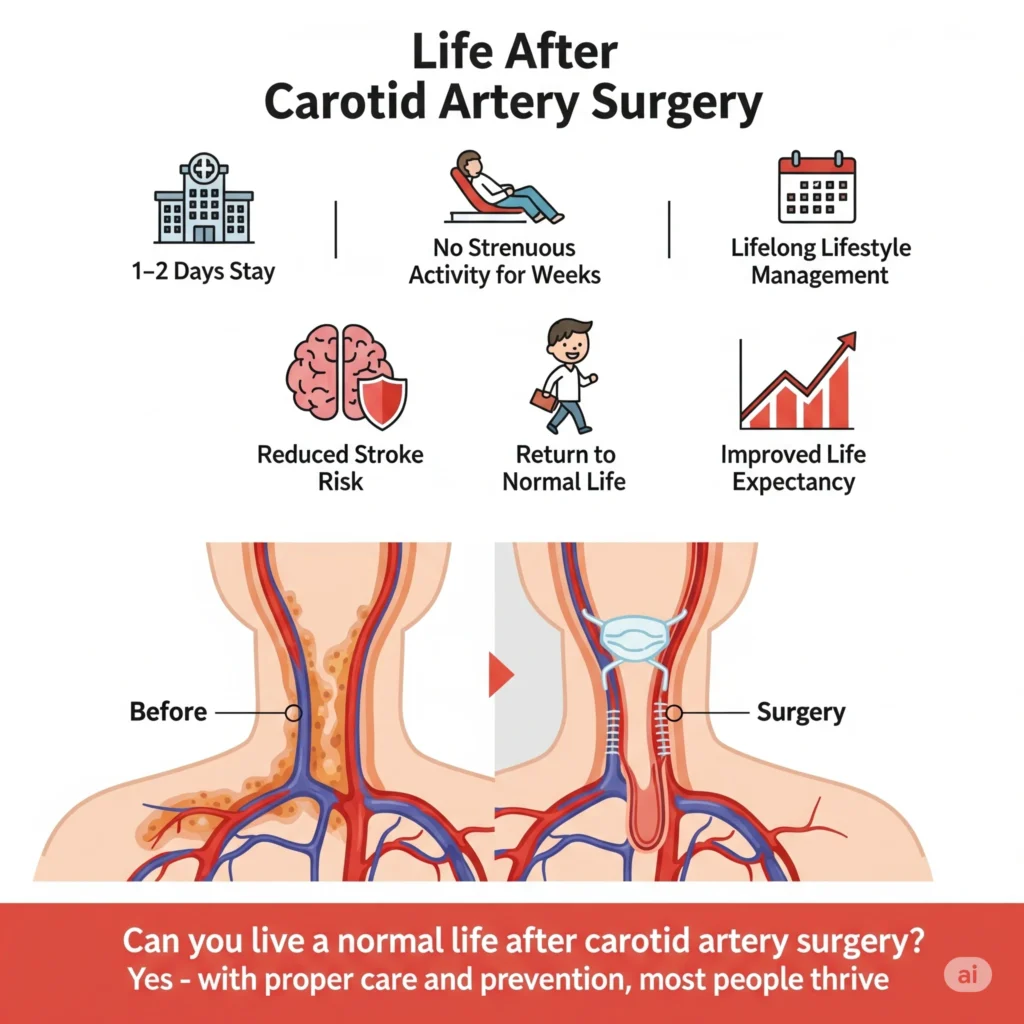
Surgery, such as carotid endarterectomy or stenting, is often recommended for severe blockages or symptomatic cases. What is life expectancy after carotid artery surgery? Most patients experience improved outcomes and can live a normal life after surgery, provided they manage risk factors. Complications are rare, but recovery typically involves:
- A hospital stay of 1–2 days
- A few weeks of avoiding strenuous activity
- Long-term lifestyle changes to prevent further plaque buildup
Can you live a normal life after carotid artery surgery? Yes, many patients return to their regular activities and enjoy a good quality of life. Surgery significantly reduces stroke risk, improving life expectancy with blocked carotid artery.
Special Cases
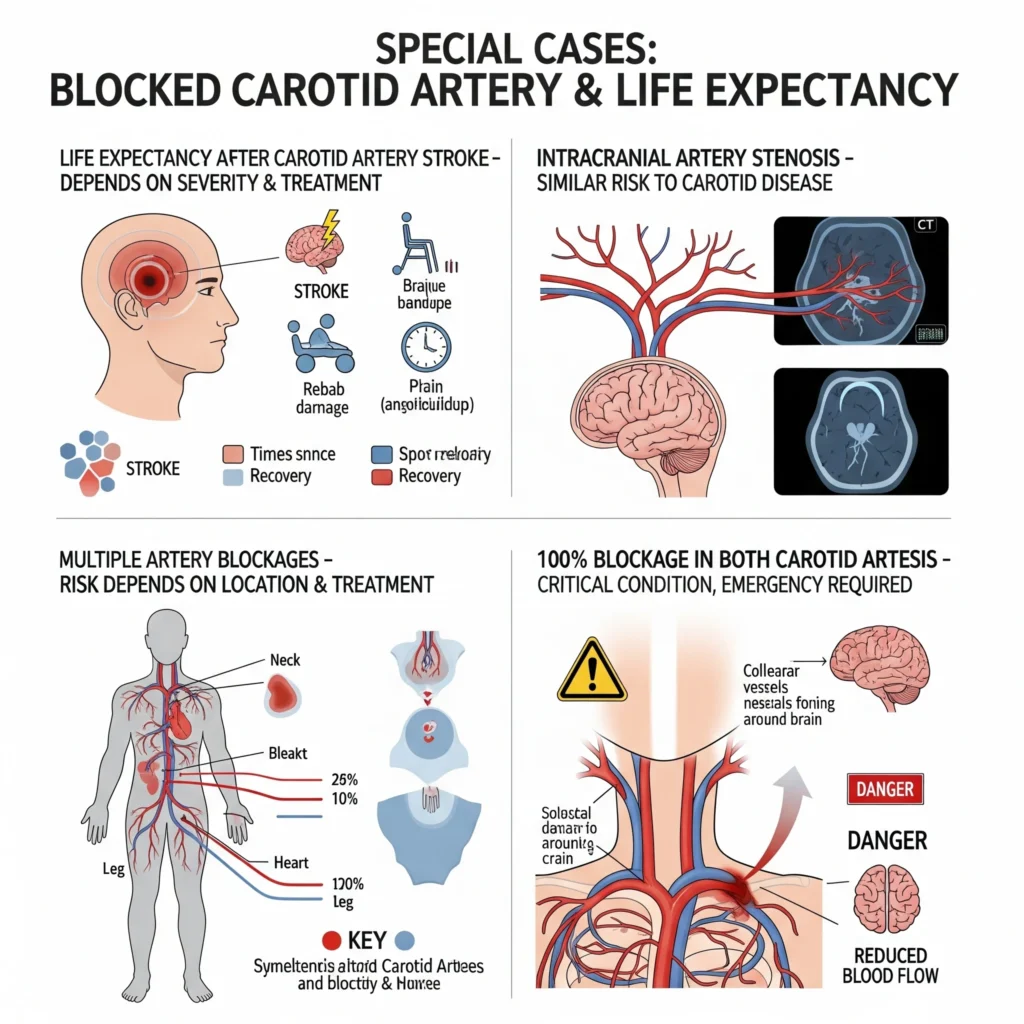
Not every case of carotid artery blockage follows a typical pattern. In some patients, the blockage may extend beyond the neck arteries and involve the arteries inside the brain — a condition known as cerebral atherosclerosis, which can impact overall brain function and life expectancy. In other situations, people may have to live with three or more blocked arteries, which drastically complicates treatment and survival outlook.
When both carotid arteries are 100% blocked, the body’s ability to deliver blood to the brain is severely impaired. In such cases, the question arises: what happens if both carotid arteries are 100% blocked? The answer often depends on how well the body develops collateral circulation to compensate for the blockage.
Similarly, people ask, how long can you live with a 99% blocked artery or how long can you live with 80% blockage? The answers depend on early detection, medical intervention, and lifestyle changes. These cases highlight why regular checkups are critical if you’re at risk of clogged arteries in the neck or intracranial artery stenosis.
Life Expectancy with Blocked Carotid Artery After Stroke
If a stroke has already occurred, life expectancy with blocked carotid artery after stroke depends on the stroke’s severity, the patient’s age, and how quickly treatment was received. Rehabilitation and ongoing medical care can help improve outcomes.
Intracranial Artery Stenosis Life Expectancy
When atherosclerosis affects arteries inside the brain (intracranial artery stenosis), the risks are similar to carotid artery disease. Intracranial artery stenosis life expectancy is influenced by the degree of blockage and treatment success, much like carotid artery disease.
How Long Can You Live with 3 Blocked Arteries?
If multiple arteries, including the carotid arteries, are blocked, the condition is more complex. How long can you live with 3 blocked arteries? This depends on which arteries are affected, the percentage of blockage, and whether treatments like surgery or stenting are pursued.
What Happens If Both Carotid Arteries Are 100% Blocked?
If both carotid arteries are 100% blocked, the situation is critical. The body may rely on other blood vessels to supply the brain, but the risk of severe stroke or death is high without urgent intervention.
Conclusion
Living with a blocked carotid artery is manageable with the right approach. Whether you’re dealing with a 70% blocked carotid artery, a 90% blockage carotid artery, or even a 100% blocked carotid artery, early detection and treatment are key to improving life expectancy with blocked carotid artery. By understanding the warning signs of a blocked carotid artery, pursuing carotid artery treatment without surgery when appropriate, or opting for surgery when needed, you can take control of your health. Consult a healthcare provider to discuss your specific situation and create a plan that works for you.
FAQs
Is 70% blockage in carotid artery bad?
A 70% blockage is concerning but manageable with treatment. It’s considered high-risk if symptoms like TIAs occur.
How much carotid artery blockage is normal?
Some plaque buildup is common with age, but significant blockages (over 50%) require medical attention.
How long can you live with 80% blockage?
With proper treatment, many people live for years, but the risk of stroke increases without intervention.
What are the symptoms of a blocked artery in your neck?
Symptoms include numbness, vision problems, difficulty speaking, and dizziness.
How long can you live with a 99% blocked artery?
A 99% blockage is extremely serious, and life expectancy may be limited without surgery due to stroke risk.



